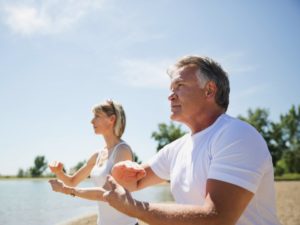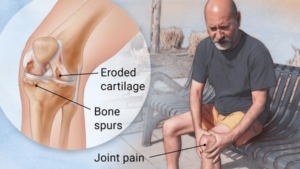Improve Cardiorespiratory Fitness in Coronary Disease Rehabilitation with Tai Chi
By John M. de Castro, Ph.D.
“practicing tai chi may help to modestly lower blood pressure. It’s also proved helpful for people with heart failure, who tend to be tired and weak as a result of the heart’s diminished pumping ability. The slow movements involve both the upper and lower body, which safely strengthens the heart and major muscle groups without undue strain.” – Harvard Heart Letter
Cardiovascular disease is the number one killer, claiming more lives than all forms of cancer combined. “Heart disease is the leading cause of death for both men and women. About 610,000 people die of heart disease in the United States every year–that’s 1 in every 4 deaths. Every year about 735,000 Americans have a heart attack.” (Centers for Disease Control). A myriad of treatments has been developed for heart disease including a variety of surgical procedures and medications. In addition, lifestyle changes have proved to be effective including quitting smoking, weight reduction, improved diet, physical activity, and reducing stresses. Cardiac rehabilitation programs for patients recovering from a heart failure, emphasize these lifestyle changes. Unfortunately, for a variety of reasons, 60% of heart failure patients decline participation, making these patients at high risk for another attack.
Contemplative practices, such as meditation, tai chi, and yoga, have also been shown to be helpful for heart health. In addition, mindfulness practices have also been shown to be helpful for producing the kinds of other lifestyle changes needed such as smoking cessation, weight reduction and stress reduction. Tai Chi and Qigong are ancient mindfulness practices involving slow prescribed movements. Since Tai Chi is both a mindfulness practice and a gentle exercise, it may be an acceptable and effective treatment for coronary disease patients.
In today’s Research News article “The Effect of Tai Chi on Cardiorespiratory Fitness for Coronary Disease Rehabilitation: A Systematic Review and Meta-Analysis.” (See summary below or view the full text of the study at: https://www.ncbi.nlm.nih.gov/pmc/articles/PMC5758591/ ), Yang and colleagues review, summarize and perform a meta-analysis of 5 published research articles on the use of Tai Chi for the treatment of patients with coronary disease.
They found that in comparison to other gentle aerobic exercise practice Tai Chi produced significantly greater improvement in cardiorespiratory fitness, or aerobic capacity, which is reflected by VO2max, measured with a stress test. But, the effect was not as great as that produced by vigorous aerobic exercise. No adverse events were reported. Hence, Tai Chi practice was found to be safe and effective in improving cardiorespiratory fitness in patients with coronary disease.
Tai Chi practice was not as effective as vigorous aerobic exercise. But it is difficult to get patients with coronary disease to engage in and sustain vigorous exercise. It scares them and produces considerable discomfort. Tai Chi practice, on the other hand, is gentle and completely safe, can be used with the elderly and sickly, is inexpensive to administer, can be performed in groups or alone, at home or in a facility or even public park, and can be quickly learned. In addition, it can be practiced in social groups without professional supervision. This can make it fun, improving the likelihood of long-term engagement in the practice. So, Tai Chi practice may be an ideal treatment for patients with coronary disease, not only one that is effective but also one that they will engage in and sustain.
So, improve cardiorespiratory fitness in coronary disease rehabilitation with Tai Chi.
“Both fear of exercise and the perception of cardiac rehabilitation as dangerous were the most commonly reported reasons for declining participation in cardiac rehabilitation. Tai chi can clearly overcome these barriers because it is a different form of exercise. During training, participants are constantly reminded they do not need to strive or struggle to achieve predetermined goals in terms of heart rate or exercise intensity. Instead, they are invited to focus their attention on the breath and/or on the movements of the body. As a result, participants do not see tai chi exercise as threatening, and this may result in improvements in exercise self-efficacy,” – Elena Salmoirago-Blotcher
CMCS – Center for Mindfulness and Contemplative Studies
This and other Contemplative Studies posts are also available on Google+ https://plus.google.com/106784388191201299496/posts and on Twitter @MindfulResearch
Study Summary
Yang, Y., Wang, Y., Wang, S., Shi, P., & Wang, C. (2017). The Effect of Tai Chi on Cardiorespiratory Fitness for Coronary Disease Rehabilitation: A Systematic Review and Meta-Analysis. Frontiers in Physiology, 8, 1091. http://doi.org/10.3389/fphys.2017.01091
Abstract
Background: Tai Chi that originated in China as a martial art is an aerobic exercise with low-to-moderate intensity and may play a role in cardiac rehabilitation.
Aim: To systematically review the effect of Tai Chi on cardiorespiratory fitness for coronary disease rehabilitation.
Methods: We performed a search for Chinese and English studies in the following databases: PubMed, EMBASE, Cochrane Central Register of Controlled Trials, Chinese Biomedical Literature Database, China Knowledge Resource Integrated Database, Wanfang Data, and China Science and Technology Journal Database. The search strategy included terms relating to or describing Tai Chi and coronary disease, and there were no exclusion criteria for other types of diseases or disorders. Further, bibliographies of the related published systematic reviews were also reviewed. The searches, data extraction, and risk of bias (ROB) assessments were conducted by two independent investigators. Differences were resolved by consensus. RevMan 5.3.0 was used to analyze the study results. We used quantitative synthesis if the included studies were sufficiently homogeneous and performed subgroup analyses for studies with different control groups. To minimize bias in our findings, we used GRADEpro to grade the available evidence.
Results: Five studies were enrolled—two randomized controlled trials (RCTs) and three nonrandomized controlled trials (N-RCTs)—that included 291 patients. All patients had coronary disease. ROB assessments showed a relatively high selection and detection bias. Meta-analyses showed that compared to other types of low- or moderate-intensity exercise, Tai Chi could significantly improve VO2max [MD = 4.71, 95% CI (3.58, 5.84), P < 0.00001], but it seemed less effective at improving VO2max as compared to high-intensity exercise. This difference, however, was not statistically significant [MD = −1.10, 95% CI (−2.46, 0.26), P = 0.11]. The GRADEpro showed a low level of the available evidence.
Conclusion: Compared to no exercise or other types of exercise with low-to-moderate intensity, Tai Chi seems a good choice for coronary disease rehabilitation in improving cardiorespiratory fitness. However, owing to the poor methodology quality, more clinical trials with large sample size, strict randomization, and clear description about detection and reporting processes are needed to further verify the evidence.
https://www.ncbi.nlm.nih.gov/pmc/articles/PMC5758591/









